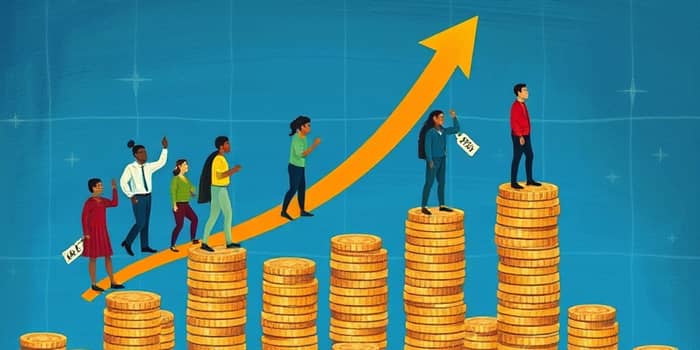
Understanding the relationship between wages and inflation is critical for policymakers, businesses, and workers. As wage dynamics evolve in a changing economic landscape, their effects on price stability and purchasing power remain central to financial debates around the globe.
In this article, we examine historical trends, dissect the complex mechanisms at play, and offer insights on how future developments could reshape economic outcomes for households and industries alike.
Before delving into data and analysis, it is essential to establish clear definitions of the primary terms and theories that underpin our discussion.
Over the past two decades, the trajectory of wages and prices in the United States has exhibited both periods of alignment and divergence. From 2006 through 2025, labor market outcomes have reflected broader economic cycles, government interventions, and global disruptions.
Between those years, nominal U.S. wages increased by 78.7%, while real wages rose only 11.9% after adjusting for inflation. This discrepancy underscores how persistent price pressures can erode the gains workers see on their paychecks.
Despite the overall lag, there were notable exceptions. In May 2020, wage growth surged to 7.5% year-over-year while prices were nearly flat at 0.1%, a distortion caused by pandemic-era labor shifts and sectoral shutdowns. Conversely, in June 2022, inflation peaked at 9.1% even though wages climbed just 4.8%, highlighting non-wage factors driving broad price increases.
For the year ending January 2025, real average hourly earnings increased by 1.0% for all employees and by 1.1% for production and nonsupervisory workers. Moreover, in the first five months of 2025, real wages for those groups rose by almost 2%, signaling a rare period of sustained purchasing-power growth.
Empirical research shows that the pass-through from wage increases to consumer prices is significantly less than one-to-one. In early 2022, had excess nominal wage growth fully translated into higher prices, inflation would have reached 4–4.5% rather than the observed 8.6%. Instead, factors such as supply chain disruptions, commodity price spikes, and profit-margin expansions played dominant roles.
Furthermore, when businesses face higher labor costs, they may offset them by boosting productivity. In 2021, productivity grew by 1.9%, but unit labor costs rose by 3.5%, indicating that output gains did not fully neutralize wage pressures. This partial offset demonstrates how productivity gains can mitigate inflationary effects when managed effectively.
The sensitivity of prices to wage changes varies by sector. Industries where labor comprises a higher share of costs are more likely to pass through wage hikes into prices. For instance, in food services labor accounts for 36.3% of gross output, while professional and business services allocate about 45.6%. In contrast, capital-intensive sectors often absorb wage costs more effectively.
Macroeconomic policies also exert significant influence. Direct fiscal support during the pandemic boosted household incomes and consumption, contributing to both wage and price surges. At the same time, historically low unemployment rates and elevated job vacancies have strengthened worker bargaining power, sustaining wage momentum even as central banks tightened monetary policy.
Wage growth and inflation interact differently across income brackets. While headline data point to average real‐wage gains since late 2019, lower-income and middle-income households often face a distinct cost profile. They spend a greater share of income on essentials such as housing, energy, and food, which have experienced above-average price increases at times.
Moreover, the choice of inflation measure matters. The CPI typically registers higher rates than the PCE index, particularly when housing costs accelerate. As such, some workers find their real incomes stretched more thinly than aggregate figures suggest.
These dynamics have sparked renewed discussions about economic inequality and the extent to which wage gains can narrow or widen the gap between high- and low-income earners. Sustainable progress in living standards will likely depend on maintaining balanced growth in wages, productivity, and price stability.
Several open questions remain as policymakers and analysts assess the durability of recent trends. Can real-wage gains continue if productivity growth falters? Will inflationary pressures reemerge if external shocks amplify supply constraints? And how will central banks calibrate interest rates in response to shifts in labor market conditions?
Importantly, the specter of a wage-price spiral remains muted so long as productivity improvements keep pace with wage demands and inflation expectations stay anchored. Ongoing monitoring of wage data, consumer‐price metrics, and output per hour will be essential for anticipating potential inflection points.
The relationship between wage growth and inflationary pressures is multifaceted and evolving. Recent data illustrate that while wages have contributed to broader price dynamics, they have not been the primary driver of post-pandemic inflation. Instead, supply disruptions, commodity cost swings, and profit margins have played larger roles.
Looking forward, fostering continued gains in real purchasing power will depend on synergistic advances in productivity, prudent fiscal and monetary policies, and sectoral adaptability. For workers and policymakers alike, nuanced interpretation of economic indicators will remain vital as the global economy navigates its next chapter.
References













